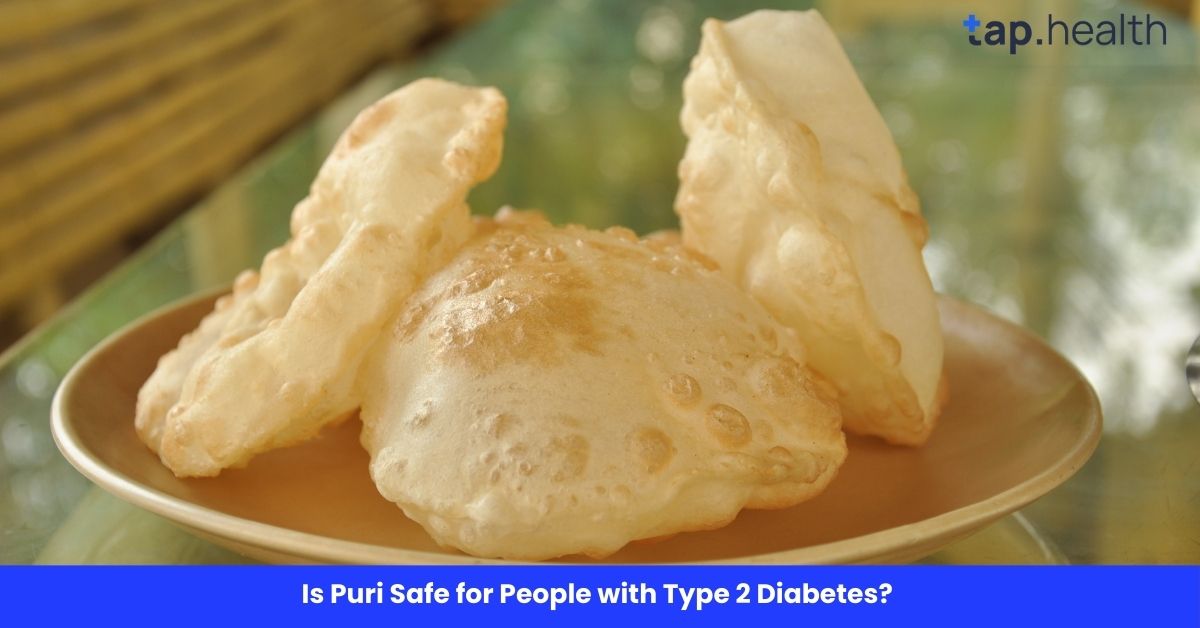Puri, a traditional deep-fried Indian bread, is a popular and beloved food in many parts of the world. Its crispy, golden texture and delicious flavor make it a go-to option for many meals. However, for individuals with type 2 diabetes, the question remains: “Is puri safe to eat?” Given its high carbohydrate and fat content, it’s important for diabetics to understand how puri affects blood sugar levels and how to incorporate it into a balanced diet.
In this article, we will explore the impact of puri on type 2 diabetes, how it can influence blood sugar levels, and what you can do to enjoy puri safely. We will also discuss healthier alternatives, portion control, and ways to balance puri with other foods in a diabetic-friendly diet.
What Is Puri and How Is It Made?
Before diving into its effects on type 2 diabetes, let’s first understand what puri is and how it is traditionally made.
1. What is Puri?
Puri is a type of unleavened bread that is popular in Indian cuisine. It is typically made by kneading refined flour (maida), water, and salt into a dough. The dough is rolled out into small, round discs and then deep-fried in oil, causing it to puff up into a light, crispy texture. Puri is often enjoyed with a variety of accompaniments such as curries, chutneys, or vegetables.
2. The Nutritional Content of Puri
The nutritional content of puri can vary depending on the size and ingredients used. However, a typical puri made from refined flour contains:
- Calories: 150-200 per piece
- Carbohydrates: 20-25 grams per piece
- Fats: 7-10 grams (mostly from deep frying)
- Protein: 2-3 grams
- Fiber: 1-2 grams
While puri offers some protein and fiber, its high carb and fat content, particularly from deep frying, make it a food that needs to be consumed in moderation, especially by people with type 2 diabetes.
Is Puri Safe for People with Type 2 Diabetes?
Puri is generally not safe for people with type 2 diabetes if eaten regularly. It’s made from refined wheat flour (maida or sometimes wheat flour) and deep-fried in oil, which makes it high in carbs, fat, and calories. This combination can cause quick spikes in blood sugar levels and also increase the risk of weight gain and cholesterol problems.
How Puri Affects Blood Sugar Levels in Type 2 Diabetes
Diabetics need to carefully manage their blood sugar levels, and the foods they eat play a huge role in this. Foods with high carbohydrate content, especially refined carbs like those in puri, can cause significant blood sugar spikes.
1. The Glycemic Index of Puri
The glycemic index (GI) is a scale that measures how quickly foods raise blood sugar levels after consumption. Foods with a high GI cause a rapid increase in blood sugar, which can be harmful for people with diabetes.
- Refined flour (maida), the primary ingredient in puri, has a high glycemic index. This means puris made from refined flour can cause a rapid spike in blood sugar levels after consumption.
- Whole wheat flour or multigrain flour puris may have a slightly lower glycemic index, but they are still relatively high in carbs and can still impact blood sugar levels if consumed in large quantities.
2. Carbohydrates and Insulin Response
When you eat a high-carb food like puri, the body breaks down the carbohydrates into glucose (sugar), which enters the bloodstream. In people with type 2 diabetes, the body either doesn’t produce enough insulin or doesn’t use insulin effectively. Insulin is needed to help regulate blood sugar levels by moving glucose from the blood into the cells.
Eating high-carb foods like puri forces the body to produce more insulin to handle the sugar. If the insulin response is impaired, this can result in high blood sugar (hyperglycemia), which can cause a variety of issues like fatigue, excessive thirst, and long-term complications such as nerve damage, heart disease, and kidney damage.
What Happens if You Eat Puri Regularly with Type 2 Diabetes?
While it’s not necessary to completely cut out puris, regularly eating puris can have consequences for people with type 2 diabetes. Let’s explore what happens if puris are consumed too often.
1. Frequent Blood Sugar Spikes
Since puris are made with refined flour and fried in oil, they are rich in simple carbohydrates and fats, which can cause rapid increases in blood sugar levels. Eating puri regularly can lead to frequent blood sugar spikes, making it more difficult to manage diabetes effectively. Over time, these frequent spikes can result in poor blood sugar control.
2. Increased Insulin Resistance
Eating foods high in refined carbs, like puris, can contribute to insulin resistance. In insulin resistance, the body’s cells become less responsive to insulin, meaning that glucose stays in the bloodstream instead of being absorbed by the cells. This leads to higher blood sugar levels and makes it harder to control diabetes.
3. Weight Gain
Puris are calorie-dense due to their fat content (from deep frying). Eating puris regularly can lead to weight gain, which is a major risk factor for worsening insulin resistance. Extra body fat, especially around the abdominal area, can make it harder for the body to use insulin effectively, leading to worse blood sugar control.
4. Increased Risk of Heart Disease
Diabetics are already at a higher risk of cardiovascular diseases, including heart disease and stroke. Since puris are fried in oil, they contain trans fats, which can increase bad cholesterol (LDL) and decrease good cholesterol (HDL). This contributes to the buildup of plaque in the arteries, increasing the risk of atherosclerosis (hardening of the arteries) and other heart-related complications.
5. Digestive Problems
Fried foods, including puris, can lead to digestive discomfort. They may cause bloating, indigestion, and acid reflux, which can make it harder for diabetics to digest their food properly. Poor digestion can lead to poor nutrient absorption and make managing diabetes more difficult.
How to Safely Enjoy Puri with Type 2 Diabetes
While regular puris may not be the best option for people with type 2 diabetes, there are healthier ways to enjoy this tasty treat without significantly affecting blood sugar levels.
1. Control Portion Size
The key to eating puri safely is portion control. Eating one or two small puris instead of several can help minimize the impact on blood sugar levels. Always be mindful of your total carbohydrate intake during a meal.
2. Choose Whole Wheat or Multigrain Puri
Opting for whole wheat puris or those made with multigrain flour is a healthier alternative. These options contain more fiber, which slows the absorption of sugars into the bloodstream and helps stabilize blood sugar levels. While they’re still carb-heavy, they’re better than puris made with refined flour.
3. Baked Puri Instead of Fried
Deep frying adds unnecessary fats and calories to puris. Baked puris are a much healthier option, as they are lower in fat and calories. Baking also preserves the texture and flavor without the need for deep frying.
4. Pair Puri with Protein and Fiber-Rich Foods
To minimize the impact of puri on blood sugar levels, pair it with protein (such as dal, chicken, or paneer) and fiber-rich vegetables (like spinach, carrots, or beans). Protein and fiber help slow the absorption of sugar and keep blood sugar levels steady.
5. Avoid Eating Puri Alone
Instead of eating puri alone, try to include a balanced meal with other nutrient-dense foods. For example, have a small serving of puri with a side of vegetable curry, lentils, or yogurt. The fiber, protein, and healthy fats in these foods will help counterbalance the blood sugar spike from the puris.
Healthier Alternatives to Puri for Diabetics
If you’re trying to limit puri consumption, here are some healthier alternatives that can satisfy your craving for Indian bread without spiking blood sugar.
1. Chapati (Whole Wheat Flatbread)
Chapati, made from whole wheat flour, is a much healthier option compared to puri. It is lower in fat and has a lower glycemic index, making it a better choice for diabetics. You can enjoy chapati with vegetables, dal, or lean protein.
2. Roti Made from Almond or Coconut Flour
For a low-carb, gluten-free option, you can make roti using almond flour or coconut flour. These are rich in fiber and healthy fats and have a much lower glycemic index than regular wheat-based rotis.
3. Oats Paratha
Oats paratha is a great alternative to puri. Made from oats flour and spices, this option is high in fiber, which can help manage blood sugar levels. Oats paratha is also a filling meal that won’t cause rapid spikes in blood sugar.
4. Cauliflower or Zucchini Fritters
For a lighter alternative, try making fritters using vegetables like cauliflower or zucchini. These can be seasoned with spices and are a great substitute for fried puris, as they are lower in carbs and higher in nutrients.
Real-Life Scenario
Ramesh, a 48-year-old man with type 2 diabetes, enjoys eating puri during weekend family breakfasts. However, he often notices a sudden rise in his blood sugar levels afterward. This happens because puri is deep-fried and made from refined flour, which the body digests quickly, leading to a rapid glucose spike.
Expert Contribution
Nutritionists and doctors often advise people with diabetes to limit or avoid puri. Experts highlight that fried foods and refined carbs are a double burden for diabetics—they not only raise blood sugar but also increase the risk of heart problems, which are already higher in people with diabetes.
Recommendations Grounded in Proven Research and Facts
Research shows that whole grains, high-fiber foods, and low-oil cooking methods help control blood sugar better than refined, deep-fried foods. Instead of puri, diabetics can opt for whole wheat chapati, multigrain roti, or steamed idli. If puri is eaten occasionally, it should be made from whole wheat flour, cooked in less oil, and paired with vegetables or protein-rich foods to reduce its glycemic impact.
FAQs on Is Puri Safe for People with Type 2 Diabetes?
1. How many puris can I eat without spiking my blood sugar?
Ideally, one or two small puris should be fine for most diabetics if eaten occasionally. Pair them with fiber-rich vegetables or protein to balance the meal and minimize blood sugar spikes.
2. What are healthier alternatives to puri for diabetics?
Healthier alternatives to puri include whole wheat chapati, roti made from almond or coconut flour, oats paratha, or vegetable fritters. These options are lower in carbs and healthier for blood sugar management.
3. Can I eat puri if I have insulin resistance?
People with insulin resistance should be cautious with high-carb, high-fat foods like puri. Consuming it in small portions occasionally, and balancing it with fiber and protein-rich foods, is essential to manage insulin resistance.
4. Does deep-frying puri affect blood sugar?
Yes, deep-frying puri increases its fat content and calorie count, which can contribute to weight gain and worsen insulin resistance. Baked puris are a healthier option for people with diabetes.
Conclusion
Puri can be enjoyed by people with type 2 diabetes, but it should be consumed in moderation and with caution. Due to its high carbohydrate content and deep-fried nature, puri can cause rapid blood sugar spikes if eaten regularly. By opting for healthier versions like whole wheat, multigrain, or baked puris, and controlling portion sizes, diabetics can enjoy puri without compromising blood sugar levels. Additionally, pairing puri with fiber and protein-rich foods will help keep blood sugar stable. Always remember to consult with your healthcare provider before making any significant changes to your diet, especially when managing a condition like diabetes.



